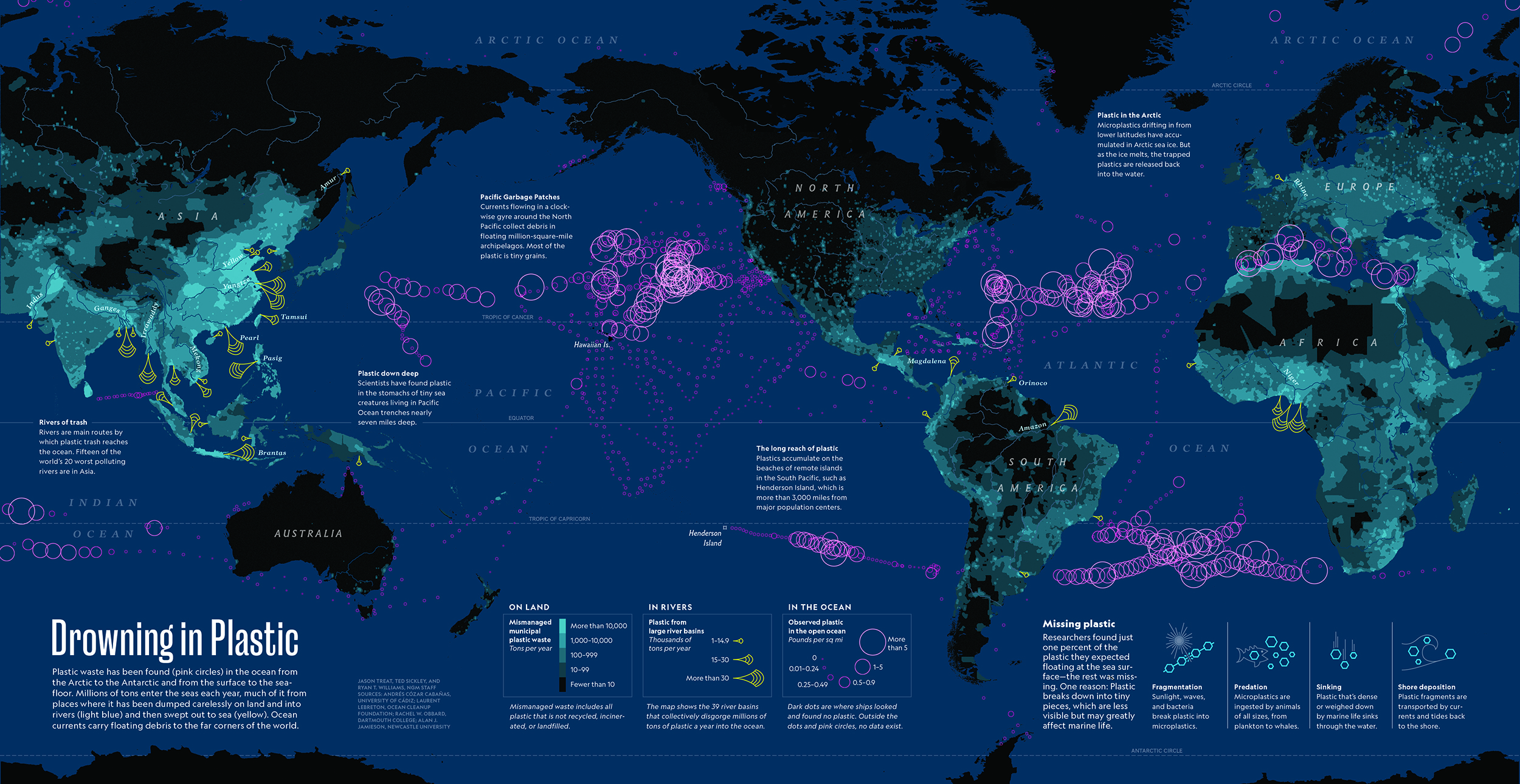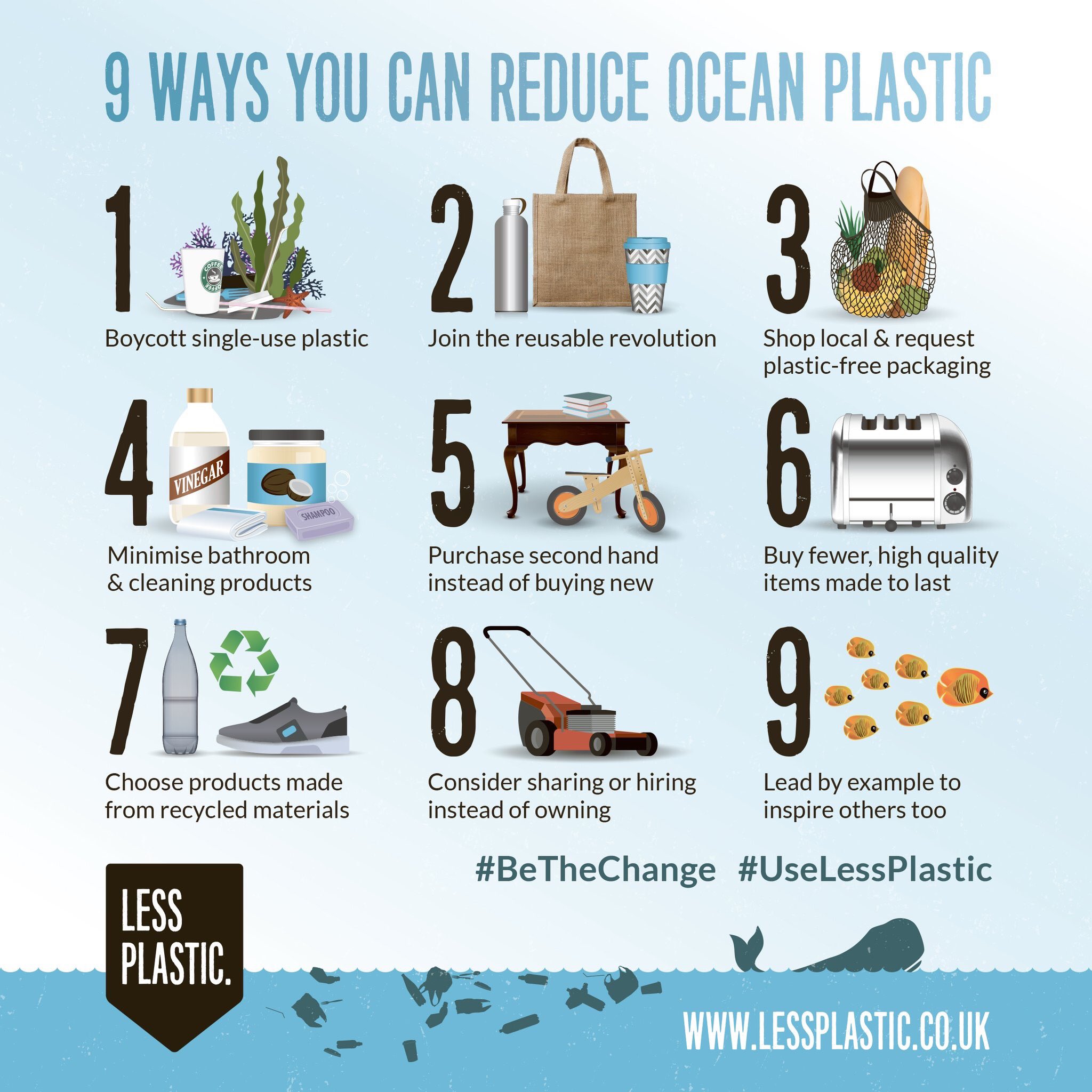We are drowning in plastic—click to enlarge!
Map by Jason Treat, National Geographic
Map by Jason Treat, National Geographic
From National Geographic
Scroll through how tons of trash travels from inland trash heaps to oceanic garbage patches. (National Geographic)
Use our terrific activities to follow the “tremendous travels of trash” and the “perils of plastic.”
Discussion Ideas
How does so much trash end up in the middle of the ocean?- directly.
Trash is often accidentally dumped directly into the ocean from shore or, more often, from ships.
Most plastic in the “Great Pacific Garbage Patch” is discarded industrial fishing gear.
Container ships also lose tons of cargo in the ocean every year, as they are tossed and turned by hazardous high seas and unsecured containers slip overboard.
Use our activity “Mapping Ocean Currents” to understand how a 1992 cargo ship spill ended up dumping nearly 92,000 rubber ducks into the Pacific Ocean.
- indirectly.
Most marine debris is actually land-based, and ends up in the ocean indirectly.
“Rainwater ushers mismanaged waste from land into local waterways, which feed into larger tributaries and rivers, which in turn empty into oceans.
In this way, plastic from far inland can travel many miles to the coastline.”
According to some sources, just ten rivers contribute 95% of river-based ocean pollution.
These plastic bottles illustrate how humans discard a shocking amount of plastic waste into the environment.
Most ocean plastic is labeled “mismanaged plastic waste.”
What is mismanaged plastic waste?
“Mismanaged plastic waste is defined as waste that doesn’t make its way to proper receptacles, either intentionally or accidentally.”
Mismanaged plastic waste tends to be higher in the developing world. Why?
Many developing countries are more likely to lack a centralized waste-disposal system.
Manila, Philippines, for example, is the urban area addressed in the Nat Geo article.
Manila “has a metropolitan garbage-collection system that stretches across 17 separate local governments—a source of chaos and inefficiency.
In 2004 the region was already running out of land to safely dump garbage.
The shortage of landfill space, and thus the crisis, continues today.”
The Pasig River, which runs through Manila and feeds Manila Bay, is one of the most polluted waterways on Earth.
Once plastic enters a marine environment, how does it travel thousands of miles through the open ocean?
- ocean currents and gyres.
The ocean is a network of currents, cycling nutrients and energy around the world. It can cycle plastic, too.
Take a look at our map for a lovely outline of ocean currents.
Tides and currents transport debris to ocean gyres.
Gyres are powerful currents that rotate in enormous circles.
Waste that is caught in a gyre spins in relatively stable areas, known as ocean “garbage patches.” Take a look at our beautiful map of the ugly problem of the five gyres.
How can individuals prevent plastic pollution?
Take the pledge. Sign up to receive helpful tips from National Geographic about how to reduce single-use plastics.
Consume less plastic. Reduce the amount of single-use plastics you consume: water and soda bottles, straws, plastic bags, coffee stirrers, lids, laminated plastic containers.
A huge amount of food packaging is single-use plastic.
Make smart decisions about buying products with excess packaging—try to avoid those cute individual containers held within larger containers.
Recycle. In addition to recycling plastics that you use, try to actively look for products made from recycled materials.
Think globally, act locally.
See how your local community is relying on single-use plastic, and try to address that specific issue.
Are students filling garbage bins with plastic packaging from lunch?
Does your school have mismanaged plastic waste? Use our activity to help guide a school-site cleanup and apply its lessons in a global context.
Are neighborhood coffee shops offering incentives to customers who bring their own cups and straws?
Does your school have a recycling program?
Are local grocery and convenience stores offering incentives to encourage customers to bring their own bags?
How permeable are the storm drains in your neighborhood?
Do they effectively filter out large plastic trash?
This could be a great Geo-Inquiry project.
Vote. Support local, state, and federal laws that encourage conservation and punish pollution.
Support local, state, and federal representatives who make protecting the environment a part of their platform.
Contact your local officials to ask how they are working to reduce our reliance on plastics, and help them come up with local solutions to local problems.
TEACHERS TOOLKIT
Nat Geo : Source to Sea
Nat Geo: What Happens to the Plastic We Throw Out?
Nat Geo: The Tremendous Travels of Trash
Nat Geo: Perils of Plastic
Nat Geo: Mapping Ocean Currents
Nat Geo: Marine Debris: A Legacy of Litter
Nat Geo: Plastic Accumulation in Ocean Gyres
Nat Geo: Planet or Plastic? Take the Pledge
Nat Geo: The Geo-Inquiry Process
Links :
- The Guardian : Point Nemo is the most remote oceanic spot – yet it’s still awash with plastic
- Smithsonian : Even the Deepest Parts of the Ocean Are Polluted With Startling Amounts of Plastic
- PopMechanics : Plastic Bag Found at the Bottom of the Mariana Trench
- CS Monitor : Global sailing race spotlights plastic pollution in oceans
- FT : Stop our oceans choking on a plastic overdose
- BigBlueOceanCleanUp



No comments:
Post a Comment